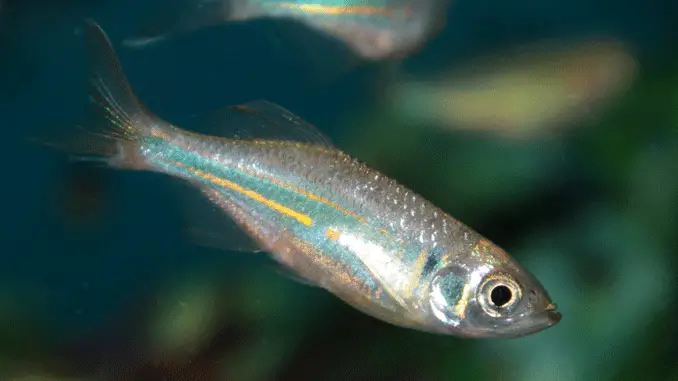
The giant danio is a freshwater species of danio from the Cyprinidae family. Giant danios are some of the biggest fish in the danio group, originating in Nepal, Sri Lanka, and the west coast of India.
While most danios grow to 1–2 inches, adult giant danios can grow to two or three times this length.
Giant danio fish have iridescent gold bodies with steel-blue spots and stripes that flash as the fish zip around the tank.
With its beautiful appearance, minimal care needs, and high energy levels, the danio is a popular fish species for beginner and experienced aquarists alike.
TABLE OF CONTENTS
Giant Danio Facts & Overview
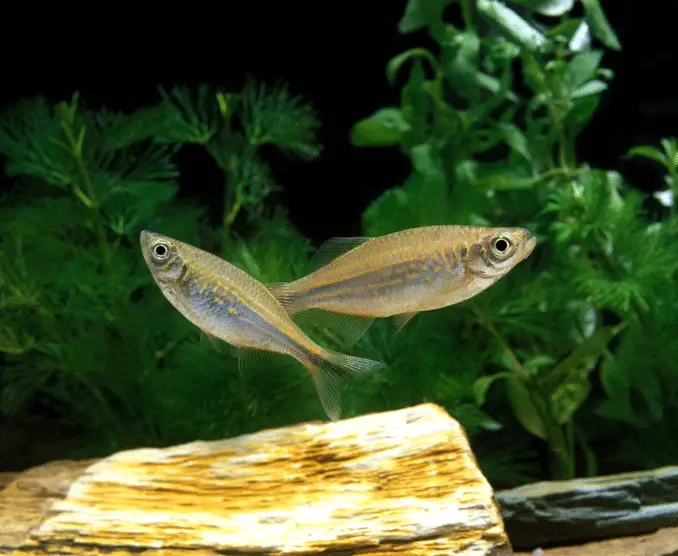
| Scientific name: | Devario aequipinnatus |
| Common names | giant danio |
| Distribution: | Nepal, northern Thailand, Bangladesh, India, and Myanmar |
| Size: | 4–6 inches |
| Life expectancy: | 5 years |
| Color: | Gold, silver, and iridescent blue |
| Diet | Omnivore |
| Temperament: | Peaceful |
| Minimum tank size: | 30 gallons |
| Temperature: | 72–75°F |
| pH: | 6.8–7.5 |
| Hardness: | Up to 20 dH |
| Care level: | Easy |
| Breeding: | Egg-scatterer |
Origin
The giant danio (Devario aequipinnatus) is found in fast-flowing rivers and hill streams in Nepal, northern Thailand, Bangladesh, India, and Myanmar.
The natural habitat of the giant danio is clear freshwater, about 1,000 feet above sea level. Giant danios are used to water without currents because the fish spend time in still ponds during the dry season.
Around 85% of Indian giant danios are captured from the wild, but the wild population of giant danios is stable.
Adult Size & Lifespan
Adult giant danios reach up to four inches long in captivity, and up to six inches long in the wild.
Males and females are the same size, but males are slimmer than females. Females also have rounder bellies than males, especially when breeding season.
The lifespan of a giant danio in captivity is five years. In the right tank environment, some giant danios live up to seven years or longer. Males and females have the same average lifespan.
Availability
Giant danios are easy to find in pet stores and online. The fish are affordable, costing between $4 and $6 per fish.
They can be bought in small groups of 3–6, making giant danios a low-cost addition to an aquarium.
Appearance & Behavior
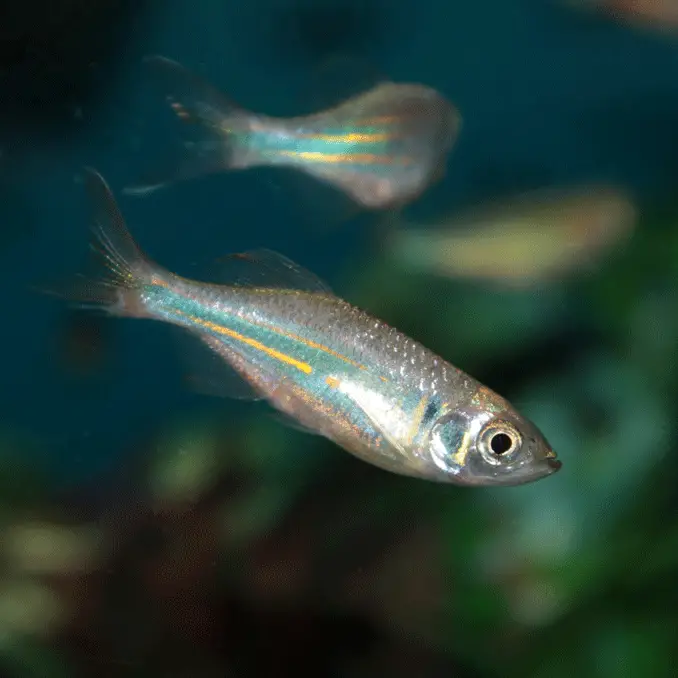
Giant danios are beautiful, with deep-blue bodies and iridescent gold spots and stripes that shimmer as the fish dart around the tank.
The giant danio’s fins are gold, rounded, and semi-transparent, and the tail is forked.
You can tell male and female giant danios apart by the fish’s appearances. Males are more vivid than females, although both fish have the same colorings and markings.
Males have stripes that run straight across the tail, while females have stripes that bend upward at the tail. Females have fuller abdomens than males, and males are slimmer than females.
A stressed giant danio will become pale silver in color, with faint markings and a pinkish hue. The more comfortable this fish feels in the tank, the bolder and brighter the fish’s coloring will become.
The tips of a giant danio’s fins become more orange during breeding season, and the stripes on the giant danio’s body become darker.
Typical Behavior
As peaceful, energetic fish, giant danios swim in the mid-section of the tank, often surfacing the water to breathe using the fish’s labyrinth organ.
Giant danios have aggressive, territorial tendencies, and bully small, slow-swimming fish if the danios don’t have enough space in the tank.
An aggressive or territorial giant danio will dart around, chasing other fish and eating small fish in the tank.
Giant danios can be kept alone, but the fish are happier when kept in groups of at least three. Groups of giant danios behave playfully, chasing and body-slamming one another around the tank.
You’ll notice giant danios swimming around the tank during daylight hours because the fish are diurnal.
Using a light in the tank during the day, and switching it off during the night will help the fish to distinguish night from day.
Giant Danio Care
Giant danios are easy to care for with the right tank size and water parameters. A big tank is essential for a happy, healthy, non-aggressive giant danio.
The giant danio’s natural habitat is fresh, clear water, and this should be replicated in a tank environment.
As active fish, giant danios require regular feeding of nutritious foods like fish flakes, frozen foods, and live foods.
Giant danios are hardy, but are still susceptible to common aquarium diseases, like ich.
Disease
Poor tank conditions and fluctuating water parameters are the most common cause of disease in giant danios. Two diseases that affect giant danios are ich and mycobacteriosis.
Ich
Ich is a common aquarium disease that is caused by a protozoan called Ichthyophthirius multifiliis. Common symptoms of ich include salt-like white spots on the fish’s body, repetitive scraping of the body against the tank walls and decorations, and a loss of appetite.
Treat fish with ich by quarantining the fish in a separate tank and increasing the temperature by two degrees to speed up the lifecycle of the protozoan.
Mycobacteriosis
Mycobacteriosis is caused by non-motile bacteria that grow in poorly-maintained tanks. Lethargy, skin inflammation, ulceration, anorexia and fin loss are all signs of mycobacteriosis.
A mycobacteriosis outbreak can be worsened by continued poor tank maintenance and fish stress. To treat mycobacteriosis, remove the affected fish from the tank and carry out regular water changes in the aquarium tank.
In a quarantine tank, treat the affected fish with antimicrobial treatments.
Habitat and Tank Requirements
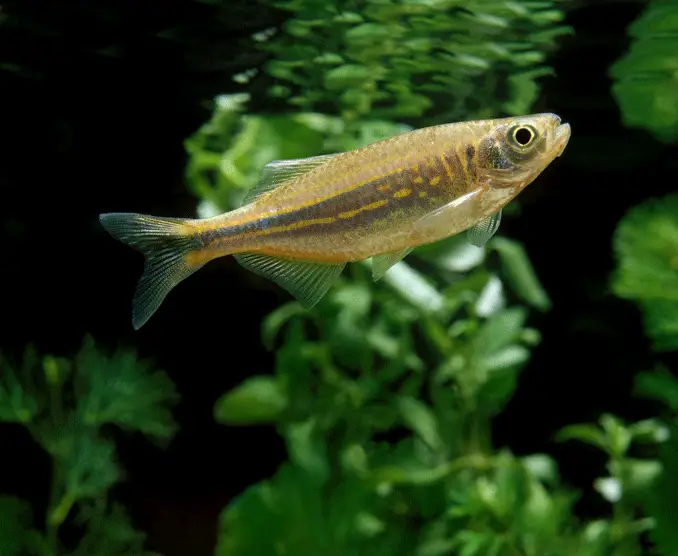
The natural habitat of giant danios is freshwater lakes and rivers in Sri Lanka, Nepal, and other eastern countries.
Giant danios are used to slow water flow or no water flow at all, dense vegetation, and plenty of open swimming space.
Replicating this natural environment in your tank will ensure that your giant danios feel comfortable and at home.
Tank Conditions
| Water type: | Fresh water |
| Tank size: | 55 gallons minimum, at least 36 inches long |
| Water temperature: | 72–75°F (22–24°C) |
| Substrate: | Any, but dark substrate shows off giant danios' scale colors |
| Tank setup: | Freshwater, gravel or sand substrate, sturdy plants |
| Acidity: | 6.8–7.5 pH |
| Water hardness: | Up to 20 dH |
| Filter: | Yes, to provide moderate current |
| Bubbler: | Yes, especially if breeding |
| Lid: | Yes, well-fitted to prevent escape |
Giant danios should be housed in freshwater tanks. The more room these active fish have to swim in, the better.
A lack of tank space can lead to aggressive and territorial behavior amongst giant danios. Ideally, aim for a 55-gallon tank minimum and at least 36 inches long. Length is more important than height for a giant danio tank.
Giant danios aren’t bottom-dwelling fish, so substrate material isn’t important. However, a dark substrate is a better choice for showing off the danios’ beautiful coloring.
Add plants like Java fern to the tank for your giant danios to explore, but be sure to place plants at the bottom and back of the tank.
Keep the middle area of the tank free for the danios to swim in. Caves and driftwood would give these fish a place to hide.
A filter is essential for a giant danio tank. Giant danios require lots of oxygen, and a filter causes water movement at the tank’s surface, speeding up oxygen exchange.
Use a filter that generates a moderate current, which danios enjoy swimming against. Air stones can also increase the tank’s oxygen levels.
Make sure your danio tank has a sturdy lid because giant danios are known to jump out of the water.
Tank Mates
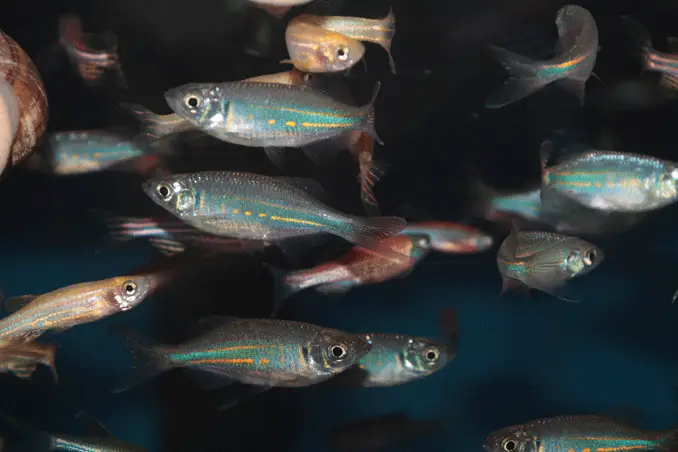
Because of the giant danio’s size, this fish shouldn’t live with small fish that the giant danio could bully or mistake for food.
Peaceful medium-to-large fish are the best tank mates for giant danios. Bottom-dwelling fish are ideal tank mates because these fish will stay out of the danio’s way.
Before considering other fish species, make sure your danios have enough tank mates of their own species.
Giant danios should live in groups of at least three, preferably six or more. They are schooling fish that become stressed when housed alone.
Other tank mates:
Aside from other giant danios, there are several other types of fish that make great tank mates for giant danios.
- Other danios: Giant danios are part of a big family of fish, and it’s safe to keep several types of danio together in the tank. Zebra danios and blue danios are good tank mates for giant danios as long as there’s enough room in the tank to prevent territorial behavior.
- Agassiz’s dwarf cichlid: As one of the most peaceful cichlid species, the Agassiz’s dwarf cichlid lives harmoniously with giant danios. These fish spend a lot of time at the bottom of the tank, digging in the substrate.
- Tiger barbs: Tiger barbs are easy to care for and entertaining to watch. These orange-and-black-striped fish are peaceful when kept in schools of six or more, and love to swim along the bottom of the tank.
- Cory catfish: One of the most popular, easy-going aquarium fish is the cory catfish, or the corydora. This fish is easy to care for, and swims along the bottom of the tank, away from giant danios.
- Clown loaches: The majority of loaches are suitable tank mates for giant danios, but clown loaches are the best of the group because of their peaceful temperaments. Like giant danios, clown loaches are active during the day.
- Non-fish tank mates: Shrimp, snails and crabs are slow-moving bottom dwellers that won’t disturb giant danios.
Giant danios are unlikely to eat these non-fish tank mates, but make sure that none of the other fish in your tank are shrimp or snail-eaters before introducing these additions to your tank.
Diet and Feeding
In the wild, giant danios eat a varied diet of worms, small crustaceans, and flying insects. You should feed giant danios a similarly varied diet at home, consisting of flakes, live foods, and freeze-dried or frozen foods.
The right diet can make the colors of a giant danio brighter and bolder.
Brine shrimp, bloodworms, daphnia, and mosquito larvae bring out the colors in a giant danio. Frozen foods are good substitutes if you don’t have access to live foods.
Nutritious foods are essential to a giant danio’s diet because of the fish’s high activity level. To ensure your giant danio follows a varied diet, occasionally feed the fish vegetable flakes or fresh, chopped-up vegetables.
Feed giant danios up to three times per day. Provide enough food per feeding session for three full minutes of eating.
Food that floats to the top of the tank is best for giant danios. These fish prefer to collect food from the water’s surface than to swim to the bottom of the tank to eat.
Breeding
Breeding giant danios and raising giant danio fry is easy. Even beginner aquarists should be able to successfully breed giant danios.
When giant danios reach 2 ¾ inches, the fish are ready to breed. For the greatest chance of breeding success, follow these steps:
- Set up a 20-gallon breeding tank with exposure to natural sunlight, which triggers spawning. Adjust the water’s pH to 7.0 or below, and set the water temperature to 77–82°F. Add plants like Java moss and spawning mop to the tank.
- Select a healthy male and female giant danio and feed the pair live foods like brine shrimp.
- Place the male and the female in the breeding tank and wait for spawning. The male will chase the female around the tank and ram against the female to indicate that he is ready to breed.
- The female will produce up to 20 eggs after every pairing. When spawning is complete, the female will have laid up to 300 eggs. You should see the eggs scattered among the plants in the tank.
- Transfer the parents to their home tank to prevent the fish from eating the fry. Use an air pump to keep the eggs oxygenated. The eggs will hatch within 36 hours.
- After another 48 hours, the fry will become free-swimming. Feed the fry freshly-hatched brine shrimp or commercial fish fry food.
Giant danios remain loyal to their mates, and the fish mate for life.
Should You Get a Giant Danio for Your Aquarium?
Giant danios are hardy, active, and attractive fish that bring entertainment value to a home aquarium.
You should consider a giant danio for your tank if you have enough space to house this large, playful fish species. Make sure the tank is large and spacious, with plenty of room for giant danios to swim laps.
If you house small fish that giant danios might eat, or if your tank is smaller than 30 gallons, you shouldn’t get a giant danio.
In the right environment, giant danios are exciting fish that provide high energy and a pop of color in your tank.

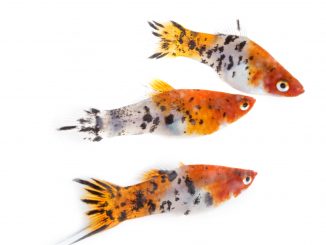
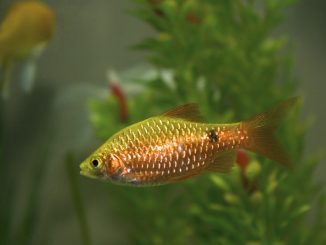
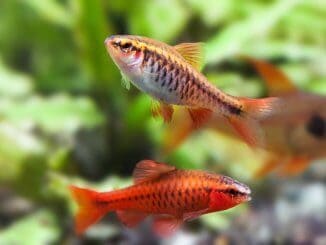
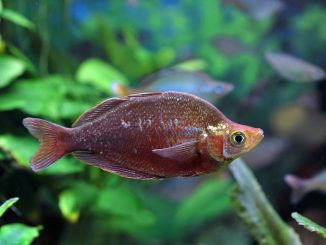
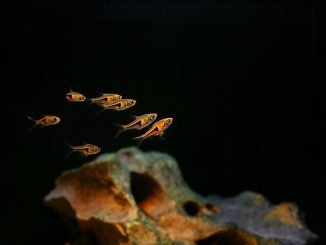
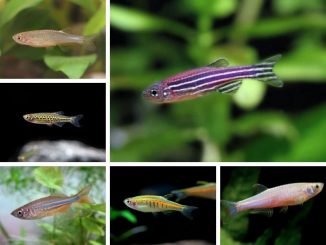
Be the first to comment